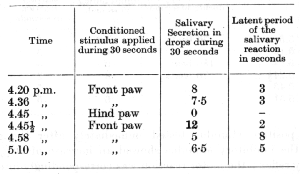
An internet resource developed by
Christopher D. Green
York University, Toronto, Ontario
ISSN 1492-3173
(Return to index)
By Ivan P. Pavlov(1927)
Translated by G. V. Anrep (1927)
Posted April 2000
[Classics Editor's note: Pavlov used both square and round brackets in his texts. These have been preserved but can lead to confusions as to which insertions are the author's and which are the editor's. Page numbers, reference numbers, and the occasional "sic" have been inserted in square brackets by the Classics editor. All other insertions (e.g., on p. 31) are by Pavlov. -cdg-]
LECTURE XI
Mutual induction of excitation and inhibition: (a) Positive induction. (b) Negative induction.
The first aspect of the intimate nature of the cortical activity which came into our field of investigation concerned the irradiation and concentration of excitation and inhibition. Only considerably later was a second aspect of this activity discovered and also subjected to a rigorous analysis. This second aspect concerned the reinforcing effect exerted by the one process upon the other, both in respect to the cortical points directly excited or inhibited and those into which the excitation or inhibition has irradiated.
This effect will be referred to as induction -- a term introduced by E. Hering and C. S. Sherrington. Induction is mutual, or reciprocal, excitation leading to increased inhibition and inhibition leading to increased excitation. The former is referred to as "the phase of negative induction," and the latter as "the phase of positive induction," or, briefly, "negative" and "positive" induction respectively.
The phenomenon of induction was observed many years ago, but, as so frequently happens in scientific research, its full significance was for a long time obscured in our minds by the idea of a smoothness of propagation of nervous processes, and those irregularities which are now known to be the result of induction, were always attributed to various casual disturbing influences, the danger of which is so great in our investigations. The first indication of induction was found in the experiments of Dr. Kogan, in which, as was shown in the ninth lecture (page 161), the stimulation of a place on the skin following immediately upon the complete extinction of another definite place much further removed revealed almost invariably a state of increases excitability. No systematic investigation of this phenomenon was, however, attempted, until recently some experiments of Dr. Foursikov focused attention upon the matter and led to its energetic investigation. The following is one of the earlier experiments of Dr. Poursikov. [p. 189]
A conditioned alimentary reflex was established to tactile stimulation of the front paw. A similar tactile stimulation of the hind paw was differentiated, the inhibition being complete, so that not a single drop of saliva appeared in response to stimulation of the inhibitory place.

It is seen that the secretory effect was increased almost 50% when the positive conditioned stimulus was applied immediately after the termination of the inhibitory stimulus, and that the latent period of the reflex was definitely shortened. Moreover, the intensity of the motor alimentary reaction of the animal was also considerably increased. Evidently, under the influence of the inhibitory stimulus (hind paw), the corresponding cortical area develops a state of inhibition, which is, as we know, retained for some time after the termination of the inhibitory stimulus. On the other hand, the cortical area corresponding to the positive stimulus (front paw), on termination of the inhibitory stimulus must be temporarily in a state of increased excitation. In this instance the interpretation is helped by the spatial relation of the two points of stimulation. The problem, however, becomes more complicated when both the positive and negative stimuli act upon one and the same cortical point, as, for example, in cases of differentiation of a stimulus according to its intensity or according to its continuous or interrupted character, or as regards the frequency of interruption in one and the same type of stimulus. The phenomenon of induction can, nevertheless, be seen in these cases also. The following is another experiment taken from Dr. Foursikov's research:
A conditioned alimentary reflex is established to a rate of 76 beats per minute of a metronome, and from this a rate of 186 beats [p. 190] per minute is completely differentiated, both with regard to the secretory and motor components of the reflex.

The positive stimulus tested immediately after the application of the inhibitory stimulus showed an increase of 30% in the secretory reflex; the motor reaction was correspondingly intensified, while the latent period of the secretory reflex was considerably shortened.
Another example of positive induction may be given from a research by Dr. Kalmykov: a positive conditioned alimentary reflex was established to strong light, and from this a reflex to weak light was completely differentiated.
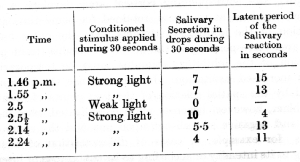
In this experiment also the positive stimulus, tested immediately after the inhibitory stimulus, showed an increase in the secretory reflex of 40%; the latent period was considerably shortened and the alimentary motor reaction was distinctly increased.
It may be questioned, in the light of the foregoing experiments, whether the phenomenon of positive induction does not really [p. 191] represent a form of dis-inhibition, The plausibility of such an interpretation is obvious, since in experiments on positive induction "new condition is introduced in the immediateness of the replacement of the negative conditioned stimulus by the positive one. This new condition might play as potent a rôle as any other fresh change in the environment in evoking an investigatory reaction, so producing dis-inhibition. However, apart from the many points of difference in detail between the phenomena of positive induction and dis-inhibition, this explanation is definitely disproved by the character of the motor reaction of the animal. This never at any time, even from the very beginning, manifests itself as a general investigatory reaction, but always as a distinctly specialized reaction corresponding to the definite positive conditioned -reflex.
The duration of induction varies from several seconds to one or two minutes. The cause of this variation has not yet been sufficiently investigated.
After this bare statement of facts, we must now proceed to a more detailed study of positive induction, especially as its occurrence was by no means so constant as might be inferred from the above account. The subject is not even yet entirely under our control, but a number of conditions on which induction depends can already be indicated.
The first of these conditions was revealed accidentally. In certain experiments with a conditioned alimentary stimulus of 100 beats of a metronome per minute' Dr. Kalmykov regularly observed a positive induction on testing the positive stimulus immediately after the withdrawal of the inhibitory stimulus of 160 beats per minute. However, when Dr. Kalmykov tried to demonstrate the experiment in the presence of several visitors, including myself, the results obtained were quite different: instead of the customary augmentation, the application of the inhibitory stimulus immediately before the positive one now caused a pronounced diminution in the positive reflex. This unexpected deviation was interpreted as follows. Since the dog was not sufficiently isolated from the sounds produced by the experimenter and the visitors, their conversation must have acted as an external inhibitory stimulus weakening the differentiation, and at the beginning even distinctly dis-inhibiting it. Positive induction could not, therefore, be exhibited at any time during the experiment. The record of this experiment is given on p. 192. [p. 192]
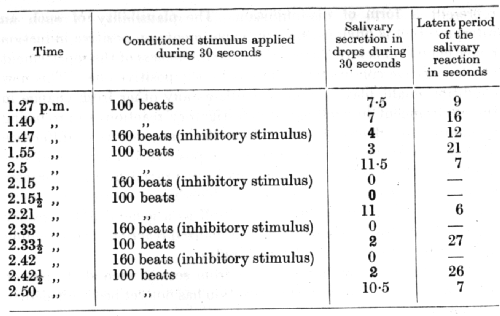
It is seen that the differentiation which previously to this experiment was complete became disturbed on its first application in the presence of visitors, 4 drops of salivary secretion being now obtained (1.47 p.m.). Later, the inhibitory stimulus applied singly gave the usual zero secretion, but throughout the experiment the inhibitory stimulus never exhibited any power of positive induction; the positive reflex tested immediately after the withdrawal of the inhibitory stimulus underwent a diminution, and was therefore influenced immediately by an inhibitory after-effect instead of the usual temporary positive induction (2.15½ p.m., 2.33½ p.m., 2.42½ p.m.).
It may be concluded from the foregoing that the weakening of the inhibitory process leads to the disappearance of induction, so that now the inhibitory after-effect begins to develop immediately, without the intervention of a preliminary heightening of excitation. In order further to test this interpretation Dr. Kalmykov reduced the intensity of the differential inhibition by intentionally subjecting it to external inhibition. For this purpose the experiment was preceded by the introduction of a rejectable substance into the mouth of the dog, when, as in the case just described, no induction could be observed throughout the experiment. It may be concluded, therefore, that the manifestation of positive induction depends upon some definite intensity of inhibition.
The second condition upon which the development of induction depends was also brought out in experiments on the same dog. [p. 193] Differential inhibition having been established-to the metronome beating at a rate of 160 per minute, it was practised for special purposes a great number of times in the course of several months without testing for induction. A more delicate differentiation to a rate of 112 beats per minute was now established (the rate of the positive stimulation being in both cases 100 beets per minute). When this finer discrimination became absolute, tests for induction were performed with the following definite result:
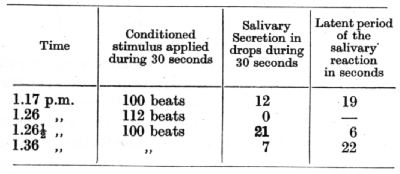
The inductive action of the new and more delicate differentiation resulted in an immediate increase of the positive secretory reflex by 75% and in a considerable shortening of the latent period. When, however, the older and coarser differentiation of 160 beats was now tested, it was surprising to find that no trace of inductive action could be observed. We thought it possible that this result might have been due to interruption in the practice of the coarser differentiation while the new and more delicate differentiation was being established, and therefore we now practised the two differentiations alternately for periods of 10-15 days each. This procedure did not, however, change the course of events, as is shown in the following tables:
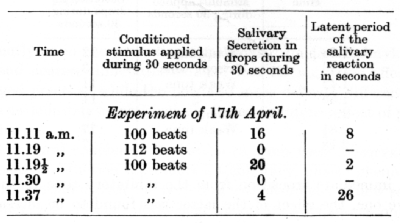 [p. 194]
[p. 194]
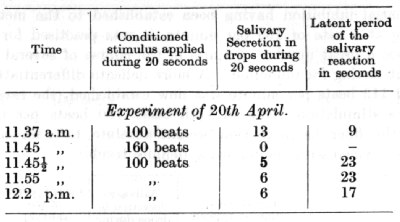
It is seen that the new and finer differentiation produced a distinct though temporary effect of positive induction (11.19½ a.m.), whereas the older and coarser one was followed directly by an inhibitory after-effect. On continuation of the experiments the effect of positive induction of the finer differentiation also began to weaken.
In similar experiments conducted by Dr. Frolov a modification was introduced by employing an inhibitory stimulus of greater intensity than the stimulus to the positive conditioned reflex. The tone D of Max Kohl's tone variator, damped to different degrees, provided the stimuli in these experiments. Three intensities of the tone were employed. The weakest served for the positive conditioned stimulus, while the remaining intensities of the tone were given inhibitory properties, the strongest tone being the first to be contrasted. When this differentiation became definitely established a test was made of its effect in producing positive induction :
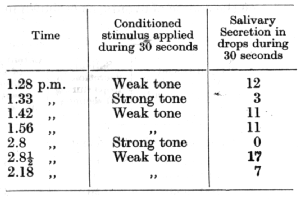
On immediate transition from the inhibitory tone to the weak positive one, the effect of the latter was found to be increased by [p. 195] 50% (2.8½ p.m.). The differentiation to the strong tone was now repeatedly practised for over a month. When tested at the end of this period if was found to have lost completely its effect of positive induction:
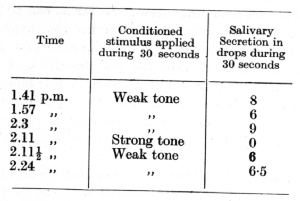
The next stage in the experiment was the formation of a differentiation to the tone of intermediate intensity. This finer differentiation was already nearing completion on its nineteenth application. The following table gives the results of a test for positive induction:
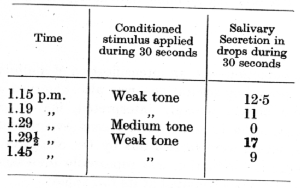
Exactly as in the preceding experiments by Dr. Kalmykov, the older and coarser differentiation had lost its inductive effect after prolonged practice, while the new and more delicate differentiation, as soon as definitely established, exhibited an intense effect of positive induction.
The natural conclusion to be drawn from these observations is that positive induction represents a temporary, phasic phenomenon, which is associated with the period of establishment of new relations in the nervous system; induction makes its appearance only with [p. 196] the maximal development of a given cortical inhibition, and disappears after the inhibition has become finally stabilized. This general rule, however, is not without exceptions, since in some cases induction is maintained during long periods of time without showing any signs of subsequent diminution. So far as can be judged from the available data, this depends on whether the rapid replacement of the inhibitory, by the excitatory, stimulus affects one and the same cortical area, as in the experiments just described, or whether the two stimuli affect two cortical areas more or less remote, as in the experiments upon the cutaneous analyser. The conditions under which induction assumes a more permanent character can be settled only by further experiments, such as are at present in progress.
It may, however, be added that a considerable number of experiments were conducted with differentiation of the rate of rhythmic tactile stimulation of some definite area of the skin. In these experiments a high rate of stimulation acted as the positive stimulus, while a low rate of stimulation acted a$ the inhibitory one. So far we have been unable to observe any positive induction with these stimuli, on rapid transition from the inhibitory to the excitatory one. In all cases there was only an immediate development of an inhibitory after-effect.
Negative induction -- i.e. an intensification of inhibition under the influence of preceding excitation--was also observed several years ago, but was always wrongly interpreted, and it only received adequate recognition in some quite recent experiments. In these experiments, which were carried out by Dr. Stroganov, the phenomenon of negative induction was repeatedly investigated in many dogs, and can now be estimated at its full value.
Negative induction was first met with in investigations on the destruction of internal inhibition. Some experiments of this type conducted by Dr. Krjishkovsky dealt especially with the destruction of conditioned inhibition. A tone employed singly was given the properties of a positive conditioned stimulus to acid, while in combination with a tactile cutaneous stimulus it served as a stimulus in a conditioned inhibition. The destruction of the inhibition was attempted by reversing the process employed in its formation, the application of the inhibitory combination being alternated with [p. 197] applications of the positive conditioned stimulus singly, but both being this time reinforced. The results obtained were quite unexpected. In spite of ten applications of the inhibitory combination with reinforcement by acid in the course of three days, its inhibitory properties remained undisturbed. These experiments are represented in the following tables:
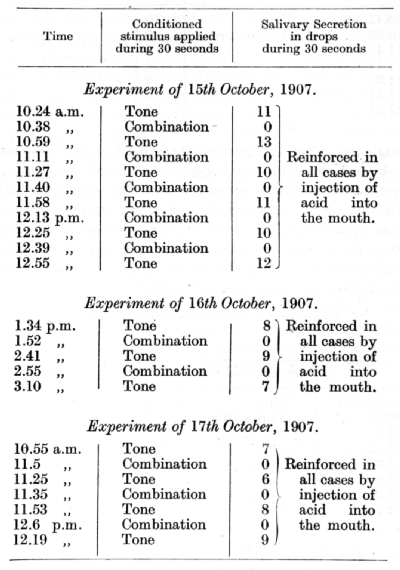
Since this method failed to produce a destruction of the conditioned inhibition, another technique was used on the day following the last experiment. The combination, which remained always reinforced, was now repeatedly applied without any intervening [p. 198] applications of the positive conditioned stimulus singly. Destruction of the inhibition was now rapidly obtained.

Although the difference between the results of the two methods seemed obvious enough, the suggestion offered itself that the destruction which developed so rapidly with the second method had been facilitated by the previous reinforcements in the earlier period of alternate application. In order to eliminate this possibility, the inhibitory combination was re-established and practised during a period of over one year, when the second method for the destruction was again applied, the result being as follows:
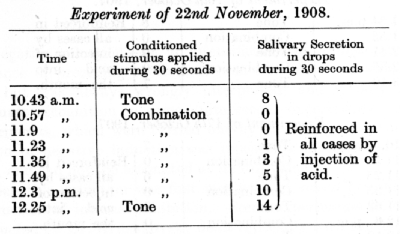
These experiments clearly demonstrate an essential difference between the two methods, but, as has already been said, the apparent anomaly presented by the first method remained for many years without any satisfactory explanation, until the question was re-investigated by Dr. Stroganov, who worked with differential inhibition. Conditioned alimentary reflexes were established in four dogs, [p. 199] differentiations being established for musical tones of differing pitch and for different rates of metronome beats. A pronounced difference in the rate of destruction of the inhibitory process by the two methods was clearly exhibited in all the dogs, without any exception. In the case of repeated application of the inhibitory stimulus with reinforcement, destruction of the inhibition was obtained after only a few applications; in the case of regular alternation of the inhibitory stimulus with the positive conditioned stimulus, on the other hand, both being followed by reinforcement, the destruction of inhibition was very much delayed, and appeared only after a great number of applications. In the different animals employed in this research sometimes the one and sometimes the other method of destruction was used first, and in every case the two methods were repeated many times with each animal. The differentiations were, of course, always well re-established before the succeeding- experimental destruction. In addition, several important variations in the experiments were made. The first variation consisted in the application of the positive stimulus after the differential inhibition had been almost altogether abolished by the use of the second method of destruction; it was found that even one single application was sufficient partially or fully to restore the inhibition (12.6 p.m; in the table below).
A rate of 120 beats of the metronome per minute served for a positive conditioned alimentary stimulus. A rate of 60 beats per minute was firmly established as a stimulus to a differential inhibition. During 41 applications within a period of 40 days it did not elicit a single drop of saliva.
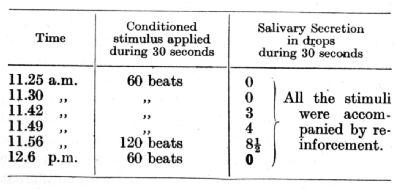
A second variation of the experiment consisted in making three successive applications of the positive conditioned stimulus just before the destruction of the differential inhibition by the second [p. 200] method was begun. This preliminary administration of the positive stimuli caused an unusual retardation of the destruction, which now required an additional five or six applications of the inhibitory stimulus.
In another dog the same positive and inhibitory conditioned stimuli were employed, and although the differentiation in this dog was less stable and, therefore, subject more easily to dis-inhibition, a similar delay was observed in its destruction.
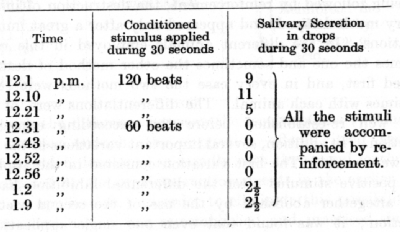
In a third variation of the experiment, after the destruction had been carried by the method of alternation to such a degree as to be already appreciable, four or five applications of the positive stimulus in succession were sufficient to reverse this effect, re-establishing the inhibition.
Another method of experiment for the demonstration of negative induction was employed by Dr. Prorokov, who made use of an old observation that the positive conditioned reflex response which was evoked second in an experiment frequently showed the greatest secretory effect. This was most probably owing to an increased excitability of the alimentary centre following on the first reinforcement with the unconditioned reflex; on this account a recently established, but not yet quite stable, inhibitory stimulus is frequently disturbed when applied in an experiment immediately after the first application of the unconditioned stimulus, the reflex being partially dis-inhibited. When several positive conditioned alimentary reflexes are present, and only one of them is associated with a differentiation, it can be observed that if one of the independent conditioned reflexes is applied first in a given experiment, the reflex corresponding to the differentiated inhibitory stimulus applied second is frequently considerably [p. 201] dis-inhibited. When, on the other hand, an experiment begins with the application of the positive one of two differentiated stimuli, the effect of the negative stimulus when applied second is but rarely, and then only slightly, disturbed. The actual experiments of Dr. Prorokov were carried out as follows. A rate of 144 beats of a metronome per minute served as a positive conditioned alimentary stimulus, while a frequency of 72 beats per minute was differentiated from it. The sound of a buzzer served as a further positive alimentary stimulus. When the buzzer was applied first in the experiment, and the inhibitory stimulus of the metronome second, the reflex to the metronome was dis-inhibited in 8 cases out of 12, the maximum dis-inhibition being 72%. When, however, the inhibitory rate of the metronome was applied after a preliminary application of the positive rate, dis-inhibition was obtained in only two cases out of 12, and it never exceeded 20%. The two procedures were always conducted in different experiments alternately, in order to preclude any effect of an increase in the stability of the differential inhibition following on repeated contrasts. The results show that, at any rate in some cases, the effect of negative induction is more especially connected with the positive stimulus to which a differentiation has been established, any other positive conditioned stimulus, even though it belongs to the same analyser, having but a small, or even no, effect of negative induction upon the inhibitory stimulus of the differentiated pair.
The two forms of experiment just described leave no doubt that under certain conditions the generation of an excitation intensifies a succeeding inhibition.
The recognition of the actual existence of negative induction naturally led us to inquire whether the effect which had previously been described under the name of external inhibition was in essence a form of a negative induction, in which the excitation initiated by extra stimuli falling upon the cortex induced a greater or less degree of inhibition in the surrounding points. The investigation is, however, somewhat difficult, since it is necessary to determine whether the external inhibition is a cortical phenomenon, or whether it takes place entirely in the lower centres of the brain, seeing that in the case of external inhibition the centres of two different unconditioned reflexes are involved. From what is known with regard to the functions of the lower parts of the central nervous system, it must undoubtedly be assumed that in the case of external inhibition [p. 202] of conditioned reflexes an interaction of an inhibitory character does occur between the centres of the two unconditioned reflexes. It must be ascertained, however, whether in the case of external inhibition there is not also a similar interaction between the various points of the cortex, and this is where the difficulties appear. An attempt was made to overcome them in experiments by Dr. Foursikov, the actual experiments being performed in the following way. Two conditioned reflexes based on different unconditioned ones were established, the one alimentary and the other a defence reflex to a strong electric stimulation of the skin. The conditioned stimulus to the defence reflex was applied, and as soon as the defence reaction appeared the conditioned defence stimulus was replaced by the conditioned alimentary stimulus. In the majority of cases the conditioned alimentary reflex suffered inhibition in a greater or less degree. Since, however, the defence reaction was present, it must be assumed that the unconditioned centre for the defence reaction was in a state of excitation, and therefore, that the possibility of an interaction of the unconditioned centres was not eliminated in these experiments. Although, however, the experiments in this form were inconclusive, they provided occasion for an observation which justified the assumption that in some cases an interaction in the form of a negative induction must also exist between the cortical points corresponding to the two conditioned reflexes. It was noticed that after the establishment of the conditioned defence reflex, the older conditioned alimentary reflex when it belonged to a different analyser suffered no diminution in intensity. When the conditioned stimuli for the two reflexes were taken from the same analyser, the establishment of the conditioned defence reflex led to a prolonged diminution in the magnitude of the conditioned alimentary reflex. Moreover, when both the alimentary and defence stimuli were related to different points of the cutaneous analyser, it was found that after the establishment of the conditioned defence reflex a diminution in the strength of the conditioned alimentary reflex was found only for those alimentary points nearest to the one which had been given properties as a conditioned stimulus to the defence reflex, the reflexes for more remote alimentary points retaining their full magnitude. Now, if the external inhibition had been confined to the centres of the unconditioned reflexes, such relations would not have been found in the cortical analysers. These observations render it highly probable that external inhibition can take place as a purely cortical [p. 203] phenomenon, of the same nature as negative induction, and that external inhibition can, therefore, be identified with internal inhibition. It may be noted that the nearest point associated with the alimentary reflex did not under these circumstances manifest any properties peculiar to the point for the defence reaction, and no motor defence reaction ever accompanied the alimentary reflex. At present a series of experiments is being conducted with the object of securing more direct evidence on this point.
There can be no doubt that the phenomenon of mutual induction described above provides a physiological basis for the large group of contrast phenomena described in connection with the physiology of the sense organs. Here, therefore, we are confronted with a further illustration of the successful application of the objective method to the study of problems hitherto considered to be exclusively within the domain of subjective investigation.